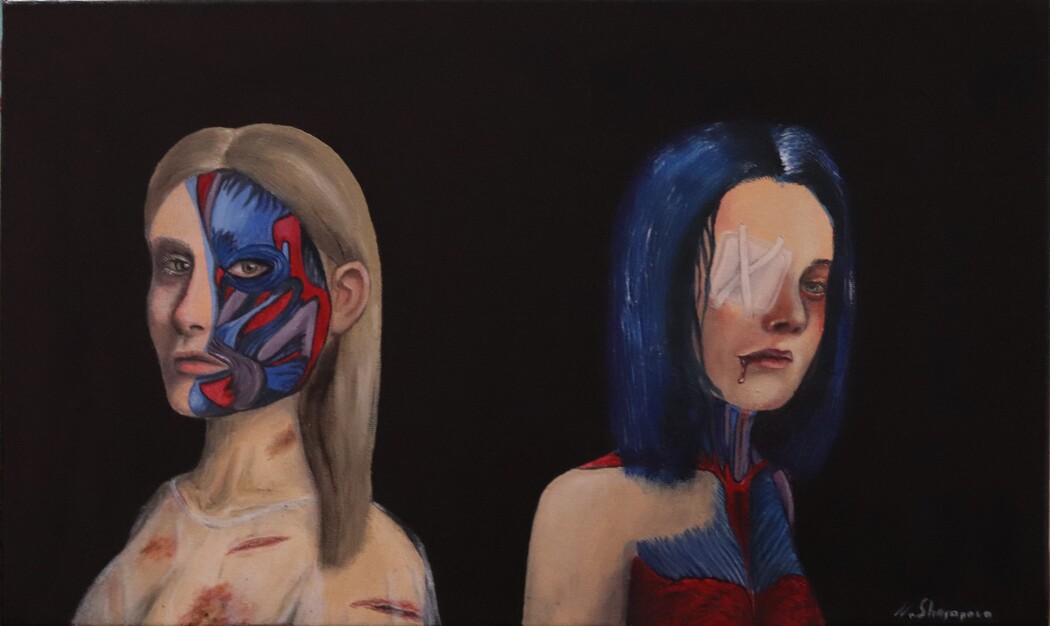Nadezda Sharapova
Year of birth: 1993
Where do you live: Chicago, USA
Your education: Shadr Art School (Russia); Bachelor’s in Oriental Studies; Master’s in International Relations
Describe your art in three words: Symbolic, emotional, layered
Your discipline: Oil painting
Website | Instagram

Can you tell us about how your experiences living across different countries have influenced your art?
Living in Russia, China, Turkey, Kenya, and now the United States has fundamentally shaped the way I see the world—and thus, the way I create. I worked, spoke the languages, and studied cultures and philosophies in depth. These experiences broke down the idea of an ultimate truth or a beauty standard. What is normal in one culture may be considered taboo in another, yet both are valid.
Over time, I stopped feeling like I belonged to only one place. I became a blend, a visual and emotional symbiosis of all the cultures I had lived in. I’ve lived both in slums and among diplomats, and experienced extremes of poverty and privilege. These contrasts taught me to notice the silent tensions in people and spaces, and my art became a way to hold these contradictions in one frame. A way of exploring them rather than resolving them. That erased the clarity of identity and replaced it with the need to search. A search I express through my work as no spoken language can hold it.
Though my technique is rooted in Russian academic training, I rarely borrow visual styles from other cultures. Instead, I incorporate folklore and mythology—symbols from Turkish, Greek, Chinese, and other traditions. I often use symbols that carry opposite meanings across cultures, inviting the viewer to interpret them through one’s own lens.
You mention that your work explores “the unspoken” — how do you navigate translating such internal states into visual art?
I paint universal emotions—nostalgia, despair, love, grief, and uncertainty. Even when depicting people or places, the focus is always on the emotion, rather than the narrative. These feelings need no translation—they’re shared across the world. The unspoken often exists in micro-emotions: tension in a hand, an avoided gaze, color theory, and its language. I use composition and open symbols so viewers can find their reflection in them.
 Nadezda Sharapova | Triptych Kyrgyzstan | 2024
Nadezda Sharapova | Triptych Kyrgyzstan | 2024
Your compositions blend Slavic, Middle Eastern, and Far Eastern influences. How do these cultures come together in your creative process?
My technique is more European, but the soul of my work comes from elsewhere. I borrow symbols, literature, and sometimes even materials from cultures that I’ve lived in. I often find similar symbols that might have the same, but sometimes radically different meanings—this internal contradiction becomes the conflict in my paintings, representing identity conflict, which is familiar to most immigrants. I don’t try to fuse cultures, instead I let their differences coexist, echoing my own layered identity.
What role does mythology play in your work, and how do you incorporate it into your pieces?
Mythology lets us speak emotional truths through metaphor. I use symbols from Greek, Chinese, and Turkish myths—not as stories but as psychological tools. Christian iconography, Islamic mysticism, Chinese and Tengri ancestor worship, and Taoist philosophy all find their way into my work. These traditions shape the unseen worlds I try to paint—the spiritual layers beneath the surface.
 Nadezda Sharapova | Lovely | 2022
Nadezda Sharapova | Lovely | 2022
Your works often involve contrast between softness and violence, or ancient and modern. Can you discuss how you use this tension in your art to convey deeper meanings?
Life itself exists in a contradiction. I’m interested in showing strength in fragility, and brutality in beauty. A flower can be suffocating. A scar can be graceful. By putting these elements together, I hope to show how complex and layered the human experience is—never entirely one thing or another. The ideal Renaissance Venus is beautiful—but so is a tired, dusty miner leaving the shaft to pay for his son’s education. Crumbling ruins of lost empires hold as much grace as modern construction sites building new hopes. A golden imperial carriage and a recycling cart both carry human stories. I don’t believe in ugliness—I believe in the common world beauty of struggle, history, nostalgia, and hope.
Could you elaborate on how you explore themes like grief, identity, and resilience through your use of color and form?
Grief isn’t black and white—it flashes. Identity isn’t solid—it shifts. I work with sudden contrasts, broken shapes, bold lines layered with delicate strokes. I start with the canvas itself. I don’t choose a canvas for a composition—I see the canvas and feel what story fits inside it.
Materials matter. Oil is soft and timeless—it speaks to memory and depth. Acrylic is sharp and dry—it captures fast emotion and brutality. Watercolor is fragile and fleeting—a moment that won’t return. Ink carries ancestral weight—it’s transcendental, like wisdom whispered through generations.
Your paintings invite reflection rather than providing clear answers. What do you hope viewers take away from your work?
My work is born from my experiences, but once it leaves me, it belongs to the viewer. They bring their own stories and see it through their own emotions and memories. That’s the beauty of any art—it doesn’t end with the author, it continues living in someone else’s perception. I want to create space for that kind of dialogue. Not to explain, but to evoke. If someone pauses, feels uncertain, or sees something they can’t quite explain—that’s success to me.

Leave a Reply